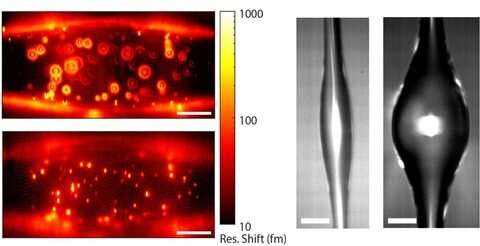Illuminating the world of nanoparticles

Scientists at the Okinawa Institute of Science and Technology Graduate University (OIST) have developed a light-based device that can act as a biosensor, detecting biological substances in materials; for example, harmful pathogens in food samples.
Current industry-standard biosensors have limited sensitivity and precision. They can only detect cumulative effects of groups of particles, rather than individual molecules.
But the tool the team developed is 280 times more sensitive.
In collaboration with researchers from the University of Wisconsin, U.S., researchers in OIST'S Light-Matter Interactions for Quantum Technologies Unit used this tool, a type of optical resonator, to create high-resolution, real-time images of individual nanoparticles. Their findings are published in ACS Nano.
Chemistry on a nano scale
For the last several years, the OIST scientists have been experimenting with microbubble resonators, a type of microresonator that consists of a hollow glass shell attached to a long, thin glass capillary. The researchers fill a microbubble resonator with water. Then, when they shine beams of light onto it, light waves circulate quickly through the water, allowing scientists to do study physical and chemical properties of particles on the resonator's surface.
For the present study, the collaborating researchers from the University of Wisconsin coated the inside of the microbubble resonator's glass sphere with gold nanorods.
The scientists shined a laser beam to heat the nanorods, then observed how the shape, orientation, and surface chemistry of the nanorods changed when they were exposed to certain chemicals and light fields.
When the nanoparticles absorbed the light shone on them, they heated up. These temperature increases caused shifts in the light frequencies emitted by the resonator, allowing the scientists to measure and image shifts in nanoparticle temperature at an incredibly high resolution.
Essentially, the resonator became an incredibly sensitive type of thermometer, the researchers said.
The scientists' next step is to apply this photothermal sensing technique to proteins, rather than nanoparticles, coating the inside of the resonator with proteins instead of gold nanorods. The researchers hope that changes in protein shape will change the optical and thermal properties of the proteins, allowing them to further study molecular events on the resonator surface.
Additionally, the method may be useful for detecting tiny viruses or single DNA strands.
"Normally if you want to get high resolution images of tiny proteins you would need an electron microscope—which would damage the protein," said Dr. Jonathan Ward, a co-author of the study. "The potential here for commercialization is huge, although, there are still many technical challenges to overcome."
More information: Levi T. Hogan et al, Toward Real-Time Monitoring and Control of Single Nanoparticle Properties with a Microbubble Resonator Spectrometer, ACS Nano (2019). DOI: 10.1021/acsnano.9b04702
Journal information: ACS Nano
Provided by Okinawa Institute of Science and Technology





















